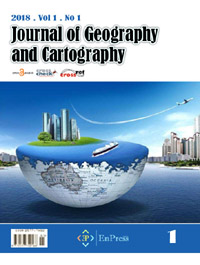|
Journal Abbreviation: J. Geogr. Cartogr. |
Journal of Geography and Cartography (JGC) is an international open access academic journal with a rigorous peer review process. We are interested in scientific topics from all fields of geography and cartography. Our ultimate goal is to make the journal a platform of global academic sources for high-quality geo-papers. JGC publishes original research articles, review articles, editorials, case reports, brief commentaries, perspectives, etc. Examples of relevant topics include but are not limited to: 1. Human geography and urban-rural planning 8. Geophysics 2. Geography science 9. Environment science 3. Geochemistry 10. Geographic information system 4. Natural geography 11. Cartography 5. Plant geography 12. Remote sensing technique 6. Hydrology 13. Geography teaching theory 7. Soil geography 14. Man-land relationship by analyzing and mapping geographic phenomena |
Online Submissions
Registration and login are required to submit items online and to check the status of current submissions.
Already have a Username/Password for Journal of Geography and Cartography?
GO TO LOGIN
Need a Username/Password?
GO TO REGISTRATION
Submission Preparation Checklist
As part of the submission process, authors are required to check off their submission's compliance with all of the following items, and submissions may be returned to authors that do not adhere to these guidelines.
- The submission has not been previously published, nor is it under the consideration of another journal (or an explanation has been provided in Comments to the Editor).
- The submission file is in Microsoft Word format.
- Where available, URLs for the references have been provided.
- The text adheres to the stylistic and bibliographic requirements outlined in the Author Guidelines, which is found in About the Journal.
- If submitting to a peer-reviewed section of the journal, the instructions in Ensuring a Blind Review have been followed.
Privacy Statement
EnPress Publisher respects and strives to protect the privacy of its users and visitors. Hence, users and visitors are encouraged to read EnPress Publisher’s privacy policy regarding the usage and handling of user information.
(1) User information
Names and email addresses entered in all EnPress Publisher’s journal sites will be used exclusively for the stated purposes of the journals and will not be made available for any other purpose or to any other party. For submission and peer review, users should register an account for further procedures, including but not limited to name, email, address, interests, affiliation, and postcode, as editors need the information to complete in-house processes (e.g., processing a manuscript).
When users visit the publisher's website, information about the visit is saved in web logs (e.g., device, IP address, time of visit, etc.), which are only used to help improve the structure and content of the website.
(2) User rights
Users have the right to register or update their personal information and contact the publisher to cancel/delete their account if required.
(3) Third-party link
EnPress Publisher is not responsible for private information obtained by third-party websites when users log in via a pop-up screen from third-party software installed on their computer.
When users visit third-party platforms (e.g., LinkedIn, Twitter, COPE, etc.) through hyperlinks from EnPress Publisher’s journal websites, the privacy policy follows the policies of the third-party platforms.
(4) Queries or contact
For any queries about EnPress Publisher’s privacy policy, please contact the editorial office at editorial@enpress-publisher.com.
Article Processing Charges (APCs)
Journal of Geography and Cartography is an Open Access Journal under EnPress Publisher. All articles published in Journal of Geography and Cartography are accessible electronically from the journal website without commencing any kind of payment. In order to ensure contents are freely available and maintain publishing quality, Article Process Charges (APCs) are applicable to all authors who wish to submit their articles to the journal to cover the cost incurred in processing the manuscripts. Such cost will cover the peer-review, copyediting, typesetting, publishing, content depositing and archiving processes. Those charges are applicable only to authors who have their manuscript successfully accepted after peer-review.
| Journal Title | APCs |
|---|---|
| Journal of Geography and Cartography | $500 |
We encourage authors to publish their papers with us and don’t wish the cost of article processing fees to be a barrier especially to authors from the low and lower middle income countries/regions. A range of discounts or waivers are offered to authors who are unable to pay our publication processing fees. Authors can write in to apply for a waiver and requests will be considered on a case-by-case basis.
*Article No. is mandatory for payment and it can be found on the acceptance letter issued by the Editorial Office. Payment without indicating Article No. will result in processing problem and delay in article processing. Please note that payments will be processed in USD. You can make payment through Masters, Visa or UnionPay card.
Vol 8, No 4 (2025)
Table of Contents
Biomass production (BIO) and its anomalies were modeled using MODIS satellite images and gridded weather data to test an environmental monitoring system in the biomes Atlantic Forest (AF) and Caatinga (CT) within SEALBA, an agricultural growing region bordered by the states of Sergipe (SE), Alagoas (AL), and Bahia (BA), Northeast Brazil. Spatial and temporal variations on BIO between these biomes were strongly identified, with the annual long-term averages (2007-2023) for AF and CT of 78 ± 22 and 58 ± 17 kg ha-1 d-1, respectively. BIO anomalies were detected through its standardized indexes - STD (BIOSTD), comparing the results for each of the years from 2020 to 2023 with the long-term rates from 2007 to each of these years. The highest negative BIOSTD values were in 2023, but concentrated in CT, indicating periods with the lowest vegetation growth, regarding the long-term conditions from 2007 to 2023. The largest positive BIOSTD values were for the AF biome in 2022, evidencing the highest vegetative vigor in comparison with the long-term period 2007-2022. The proposed BIO monitoring system is important for environmental policies as they picture suitable periods and places for agricultural and forestry explorations, allowing sustainable managements under climate and land-use changes conditions, with possibilities for replication of the methods in other environmental conditions.
The persistence of coastal ecosystems is jeopardized by deforestation, conversion, and climate change, despite their capacity to store more carbon than terrestrial vegetation. The study’s objectives were to investigate how spatiotemporal changes impacted blue carbon storage and sequestration in the Satkhira coastal region of Bangladesh over the past three decades and, additionally to assess the monetary consequences of changing blue carbon sequestration. For analyzing the landscape change (LSC) patterns of the last three decades, considering 1992, 2007, and 2022, the LSC transformations were evaluated in the research area. Landsat 5 of 1992 and 2007, and Landsat 8 OLI-TIRS multitemporal satellite images of 2022 were acquired and the Geographical Information System (GIS), Remote Sensing (RS) techniques were applied for spatiotemporal analysis, interpreting and mapping the output. The spatiotemporal dynamics of carbon storage and sequestration of 1992, 2007, and 2022 were evaluated by the InVEST carbon model based on the present research years. The significant finding demonstrated that anthropogenic activity diminished vegetation cover, vegetation land decreased by 7.73% over the last three decades, and agriculture land converted to mariculture. 21.74% of mariculture land increased over the last 30 years, and agriculture land decreased by 12.71%. From 1992 to 2022, this constant LSC transformation significantly changed carbon storage, which went from 11,706.12 Mega gram (Mg) to 9,168.03 Mg. In the past 30 years, 2,538.09 Mg of carbon has been emitted into the atmosphere, with a combined market worth of almost 0.86 million USD. The findings may guide policymakers in establishing a coastal management strategy that will be beneficial for carbon storage and sequestration to balance socioeconomic growth and preserve numerous environmental services.
Announcements
Research News: Harnessing artificial intelligence (AI) towards the landscape of big earth data: Methods, challenges, opportunities, future directions |
|
Highlights:
|
|
| Posted: 2025-06-04 | More... |
Notification of publication frequency change! |
|
.jpg) |
|
| Posted: 2025-01-10 | More... |
Congratulations to our Editorial Board Member Prof. Danfeng Hong, on Being Recognized as a 2024 Highly Cited Award Recipient by Clarivate Analytics |
|
 |
|
| Posted: 2024-12-09 | More... |
| More Announcements... |






 Open Access
Open Access
